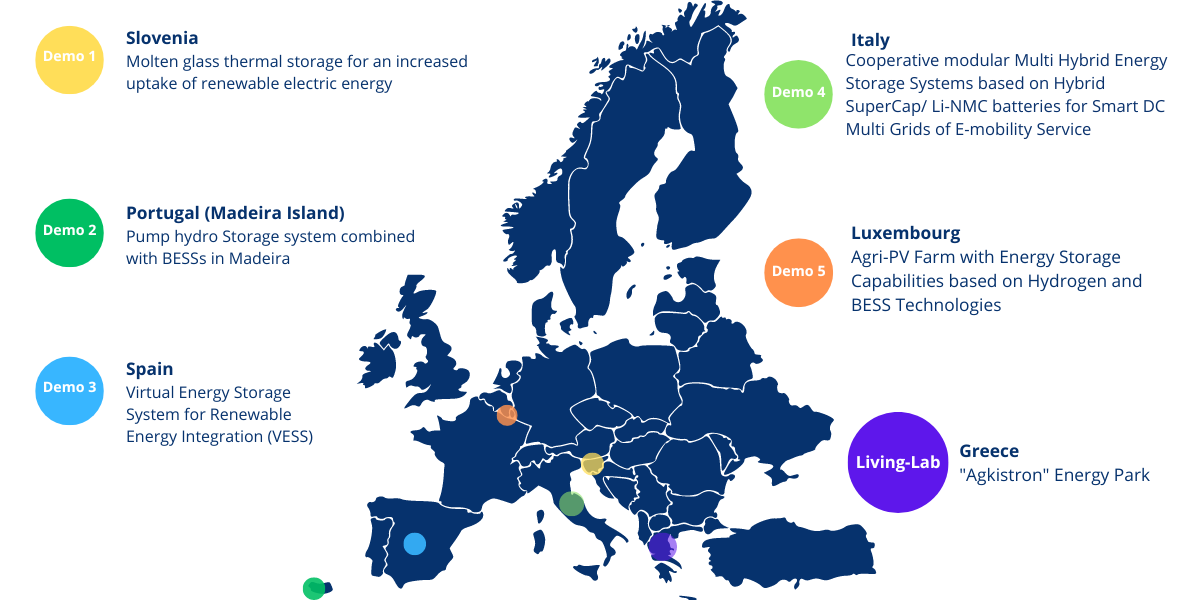Pilots
i-STENTORE Demonstrators and Living-Lab
5 Demos’ and 1 Living Lab’s scenarios will be monitored and evaluated to assess the potential to scale and replicate the results achieved in the demo, as well as through the use of a methodological framework for assessment of i-STENTORE from a technological, economic, societal, environmental, regulatory perspective.
We will cover to the largest possible extent a versatile mix of energy storage technologies, covering energy intensive applications in different sectors including industry, agriculture, commercial applications, and mobility.
The activities will focus on illustrating specific functions and serving real needs and existing challenges, engaging different actors of the energy storage value chain with different characteristics, such as storage and micro-grid operators and DSOs showcasing new business concepts, highlighting the multi-purpose potential of storage and examining different timeframes for service-provisioning.
This holistic approach will enable to test the non-exhaustive set of i-STENTORE technological solutions and services which could be expanded by third parties in the future.

+ Living Lab as a technology sandbox - Greece
![]()
A range of different renewable energy sources and energy storage technologies constitute the i-STENTORE “living lab”. The aim is to bring together the technology providers of the project with the end-users and application owners to allow for a continuous interaction by presenting the technologies developed and testing scenarios, enhancing the understanding of societal challenges, organising large-scale virtual demonstrations. The development of this high-TRL demonstration site will:
- Facilitate interaction between technology providers, end-users, and application owners in the field of renewable energy sources and energy storage technologies.
- Present and showcase the developed technologies and testing scenarios to the relevant stakeholders.
- Enhance understanding and awareness of the societal challenges associated with renewable energy and energy storage.
- Organise large-scale virtual demonstrations to effectively showcase the potential and benefits of the technologies in real-world applications.
- Foster collaboration and knowledge exchange among participants to drive innovation and advancements in renewable energy and energy storage.
- Identify opportunities for further development and refinement of the technologies based on feedback and insights from end-users and application owners.
- Support policy-making and decision-making processes by providing valuable insights and data on the performance and impact of renewable energy and energy storage solutions.
- Encourage investment and market growth in the renewable energy and energy storage sectors through increased awareness and demonstration of their viability and potential benefits.
+ Demo 1 – Slovenia
Molten Glass Thermal Storage for an increased uptake of Renewable Electric Energy
Steklarna Hrastnik (HRAS) is an innovative manufacturer of premium container glass products with more than 160 years of tradition, located in Zasavje, a Slovenian coal region in transition. HRAS recognizes the utilisation of local renewable energy sources (RES), through both increased electrification of the glass production process and the use of clean energy vectors (e.g., hydrogen), as a necessary step for a secure and clean future. Particularly, HRAS is currently in the process of replacing the glass furnace at one of its production facilities with an innovative hybrid regenerative furnace with a capacity of 170 tons/day. Within i-STENTORE, the aforementioned hybrid regenerative furnace will be coupled with a 521 kWp photovoltaic (PV) power plant to serve as a molten glass thermal storage (3 MWh), whereby the glass melting process will be aligned with the availability of RES through coordinated manipulation of electric melting (boosting) at uncompromised glass batch quality.+ Demo 2 – Portugal, Madeira Island
![]()
Pump hydro Storage system combined with BESSs
The Madeira Island small scale and isolated power electric system (not interconnected), intends to increase the sustainability of the generation system of the island and to contribute to its decarbonization, namely by increasing the share of renewable generation. To accomplish that, EEM, as the single TSO/DSO in the region, must provide technical conditions and infraestructures so that the electrical grid always assures the security of supply and grid stability in terms of frequency and voltage. Together with existing assets, such as large scale BESS and pump hydro storage systems, i-STENTORE demo will investigate, plan, develop and install a VRF (Vanadium Redox Flow) BESS of 50 kWh/50 kW to test and evaluate the best way to further increase the flexibility and resilience of this system, even with a predictable major increase of renewable energy sources. The objective of integrating this innovative storage (VRFB) device in Madeira Island’s electric system is mainly to test new electrolytes to improve the performance of the battery, increase lifetime and decrease cost, and also, to simulate the coordination of its operation with the local assets, in particular, with the existing li-ion battery, sunchronous condensers and pump hydro.+ Demo 3 – Spain

Virtual Energy Storage System for Renewable Energy Integration (VESS)
The Spanish DEMO will be developed in the province of Granada, in the south of Spain, where a Li-ion battery and a Vanadium Redox Flow Battery will be installed over an electrical area controlled by the same distribution system operator. These storage assets will be operated in conjunction with a manageable hydropower plant to behave as a Virtual Energy Storage System in order to provide flexibility and ancillary services to the DSO, as well as storage services to a photovoltaic and a wind power plant located on the same distribution grid. The hybridisation of the aforementioned storage technologies will be implemented through cloud-computing optimisation algorithms that will generate operating schedules for each asset, resulting from its participation in the energy markets and the scheduled services to be provided to the DSO and the renewable power plants. The main advantage is that these algorithms will take into account the characteristics of the storage technologies, minimising their disadvantages by complementing and exploiting their best features. Additionally, real-time information will be exchanged with the local controller of each asset and with the DSO’s SCADA via a Hierarchical Operation and Control System to ensure grid operation reliability.+ Demo 4 – Italy

Cooperative Modular Multi Hybrid Energy Storage Systems based on Hybrid SuperCap /Li-NMC batteries for Smart DC MGs of E-mobility Service demo carries out a Multi-Charger Hub for EV-Mobility Service
The demo carries out a Multi-Charger Hub for EV-Mobility Service. The Hub uses Innovative Storage Systems based on Hybrid Supercapacitor/NMC battery technologies and AC/DC Smart Micro-Grid architecture for integrating PV source. The Multi-Charger Hub consists of different charging slots integrated with a PV source (30 kWp) and distributed Energy Storage Systems (ESSs): • Fast-DC Charger • Ultra-Fast Charger • Portable Swappable Battery Charger on Demand The integration of ESS is realized for Ultra-Fast and Mobile Chargers. The Ultra-Fast Charger uses Semi-Active HESS configuration based on Hybrid Supercap nd NMC batteries. The Hybrid Supercap or LTO batteries are a hybrid solution of battery and supercap able to assure improvement in terms of energy (up to 100/200 Wh/kg) and power density (up to 1.5 kW/kg) ensuring high life cycle (up to 100.000). The most promising technologies are Lithium ion Capacitor, LTO, LiC, Sodium ion Capacitor, NiC and Zinc ion Capacitor, ZiC. The hybridization of ESS allows to reduce the stress of NMC battery in terms of maximum repetitive C-rate and ensuring the EV Ultra-Fast Charging performance. Energy management for on Demand Service using both Battery to Vehicle (B2V-Mobility Service), Vehicle to Grid (V2G), and Battery to Grid (B2G-Energy Service) will be implemented.+ Demo 5 – Luxembourg
![]()
